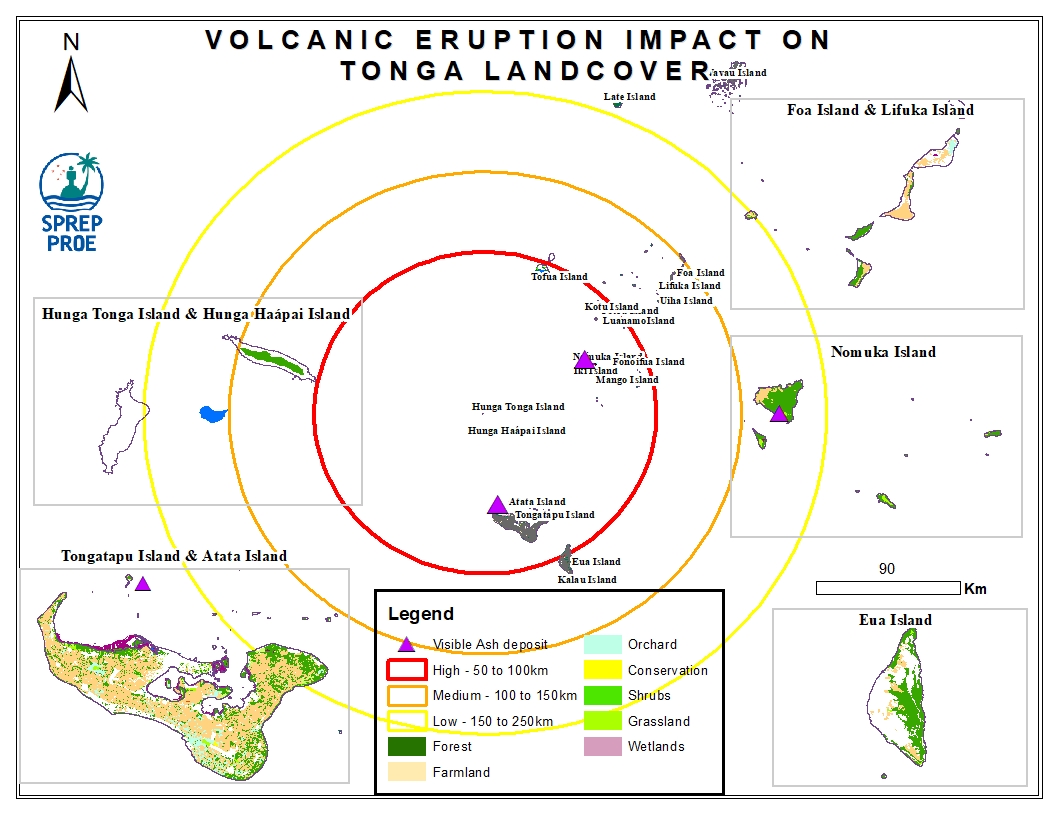Refer to dataset description for information. Please use this version for double-sided printing.
Please refer to dataset description for further information.
Strandings of Oceania Database Protocols for data users
The Pacific Islands Framework for Nature Conservation and Protected Areas 2021 – 2025 was made possible through the support of the members and partners of the Pacific Islands Roundtable for Nature Conservation (PIRT), Secretariat of the Pacific Regional Environment Programme (SPREP) and support for publishing from the African, Caribbean and Pacific (ACP) Multilateral Environmental Agreements (MEA) Phase 3 Programme (ACP MEAs 3).
Situation overview of the Tonga Volcanic eruption as of 16th January 2022.
Situation overview for the Tonga volcanic eruption as of 17th January 2022.
Situation overview for the Tonga volcanic eruption as of 18th January 2022.
The map shows the location of the Hunga Tonga - Hunga Ha’apai volcanoe in relation to the surrounding pacific island countries.
Damage assessment in Atata Island, Kolovao district, Tongatapu division, Tonga as of 18 January 2022
This map illustrates impact of the Hunga Tonga-hunga Ha'apai volcanic eruption and subsequent tsunami in the Atata island (Kolovao district, Tonga) and the related damage assessment as detected from a Pleiades image acquired on 18 January 2022.
Source : :United Nations Satellite Centre(UNOSAT)
This map illustrates effects of the Hunga Tonga-hunga Ha'apai volcanic eruption in Nomuka island (Mu'omu'a district, Tonga) and damage assessment as detected from a Pleiades image acquired on 17 January 2022.
250 structures identified. 104 structures were analyzed in the cloud-free area and 41 structures were identified as damaged and almost all the structures were covered with ash. This is a preliminary analysis and has not yet been validated in the field
The report describes Preliminary Satellite-Derived Damage Assessment Status for the Kingdom of Tonga - Affected structures and affected facilities observed in all island after tsunami triggered by volcanic eruption.
Source : UNOSTAT
This map illustrates effects of the Hunga-Tonga Hunga- Ha'apai volcanic eruption in Mango island and damage assessments as detected from a Kompsat-3 image acquired o 18 January 2022. UNOSTAT identified 26 structures as damaged and/or destroyed and 1 structure as potentially damaged. The entire island appears to be covered with ashes. This is a preliminary analysis and has not yet been validated in the field
The Hunga Tonga-Hunga Ha'apai massive undersea volcanic eruption occurred on the 15th of January 2022 and led to an induced tsunami event. The eruption triggered a tsunami warning for several South Pacific island nations with rising water levels were reported on the coastline of Peru and the Pacific Coast in the United States and caused devastating impact across Tonga. In addition, volcanic ash residue was also visible on land surfaces including building structures and surrounding vegetation.
This dataset contains preliminary impact assessments of the Hunga-Tonga-Hunga-Ha'apai volcanic eruption and induced tsunami in January 2022.
The eruptions sent a plume of ash, gas and steam 20 kilometers (12.4 miles) into the air. Satellite imagery showed a massive ash cloud and shockwaves spreading from the eruption. Ash was falling from the sky in the Tonga capital, Nuku'alofa, Saturday evening and phone connections were down. The eruption was likely the biggest recorded anywhere on the planet in more than 30 years, according to experts.
This dataset contains all spatial data that is related to the Tonga volcanic eruption. Maps produced are derived from credible data source such as UNOSTAT and UNITAR.

This publication intends to assist project designers, regulators and decision makers to anticipate and address all relevant public health, socio‐economic and environmental concerns that may arise when under‐ taking a desalination project, for obtaining maximum beneficial use of the desalinated water in terms of quality, safety and environmental protection.
Case study from Kiribati is linked at the bottom of this dataset
"Comparison of the average hard coral cover between the three five-year periods comprising the last 15 years (2005-09, 2010-14, 2015-19, Tab. 9.3) indicated that there was a high degree of confidence (93%) in the long-term decline, despite the uncertainty in individual yearly estimates. Further, the vast majority (90%) of this decline occurred between 2010-14 and 2015-19, suggesting that the rate of decline in hard coral cover has accelerated during the last five years"